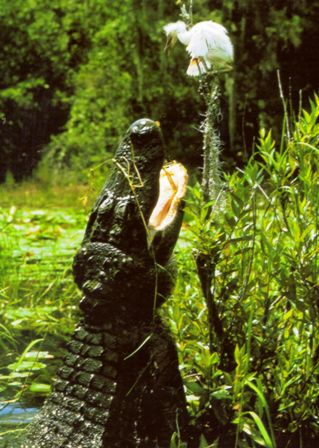 While we anticipate the upcoming gator football season, lets take a close look at our namesake, the Florida Alligator. A big shout out to Floridian Nature for providing the information!The
alligator is certainly Florida's most famous animal. When Spanish
settlers first saw the Alligator they named it "el lagarto",
meaning "the lizard". The Florida alligator is an ancient reptile that
is only found in the Southeastern United States, from Texas to as far
north as North Carolina. The only other species of alligator in the
world is found in China, but that one is much smaller and very rare.
While we anticipate the upcoming gator football season, lets take a close look at our namesake, the Florida Alligator. A big shout out to Floridian Nature for providing the information!The
alligator is certainly Florida's most famous animal. When Spanish
settlers first saw the Alligator they named it "el lagarto",
meaning "the lizard". The Florida alligator is an ancient reptile that
is only found in the Southeastern United States, from Texas to as far
north as North Carolina. The only other species of alligator in the
world is found in China, but that one is much smaller and very rare.Alligators, although not as abundant as they once were in Florida can be found in virtually every freshwater body of water, including lakes rivers, ponds and even retention areas. Occasionally found in brackish water around mangrove swamps, alligators can tolerate a reasonable degree of salinity, though not to the degree of crocodiles. In the Everglades, alligators seek refuge during the dry season in "gator holes". After swimming, you will often see an alligator sunning itself on the riverbanks, shores, or even a large log. When a gator is swimming on the surface, only its head and part of his back protrude above the water. While in this position an alligator can breathe, see, hear, smell, and taste. Gators also spend a lot of time submerged and can stay underwater for up to three hours at a time. A gator swims with its legs tucked against its body, moving forward quietly by sweeping its powerful tail from side to side. While swimming in this manner, an alligator can quietly approach its prey, looking more like a floating log than a dangerous reptile!
The Alligator has an armored black, lizard-like body, with muscular tails and short stocky legs. They are fast predators on both land and water, able to run as fast as 20 mph for short distances. The massive jaws of the alligator's open mouth reveals 70-80 white pointed teeth, designed to grasp, hold and crush its prey! The alligator snout is broad with the edge of the upper jaw overlapping the teeth of the lower jaw. The alligators silvery eyes sit back on the top of the head, and they have excellent vision, even at night. Alligators Eyes will shine red when you shine a light on them at night Alligators have two sets of eyelids. One set is similar to humans, while the second set of eyelids is transparent, allowing the gator to see clearly underwater. Florida Gators also have a keen sense of smell. Adults generally take one of two forms: long and thin or short and stocky. Female alligators rarely exceed 9 feet in length, but males can grow much larger. The Florida state record for length is a 14 foot 5/8 inch male, while the state record for weight is a 1,043 pound (13 feet 10 1/2 inches long) male.
Alligators are opportunistic feeders, and are often stealthy "sit and wait" predators. Their diets include prey species that are abundant and easily accessible. Alligators will eat just about anything, but primarily consume fish, turtles, and snails. Small animals that come to the water's edge to drink make easy prey for the voracious alligator. Sometimes a hungry alligator will even resort to eating his own kind! If a gator cannot swallow its prey whole, it pulls, twists and tears, until gulp size chunks are torn off. With large prey such as deer, the alligator performs the "gator roll", pulling the victim underwater, and rolling with it until the prey drowns.